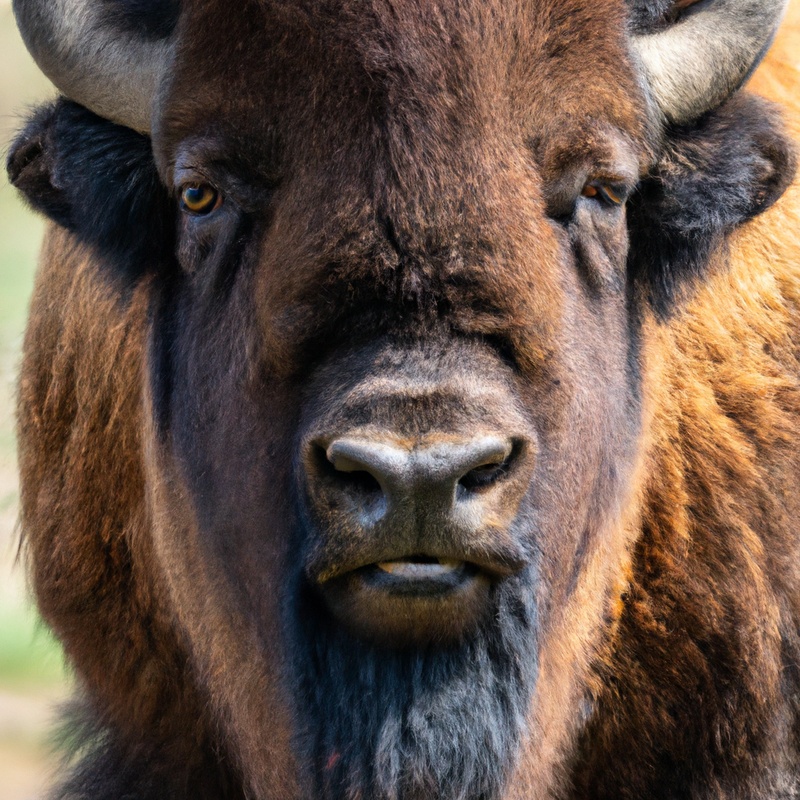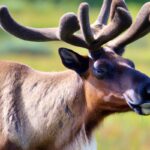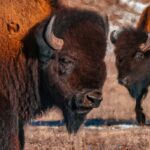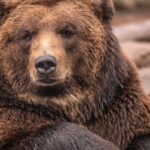Key Takeaways:
- Historical records show that hunting bison in Alaska was integral to the survival of indigenous communities.
- The decline of bison populations in Alaska can be attributed to a combination of overhunting and habitat loss.
- Efforts are being made by organizations and communities to restore bison populations and preserve their cultural significance.
- Sustainable hunting practices and conservation efforts are crucial to ensuring the long-term survival of bison in Alaska.
Have you ever wondered what it’s like to stand face to face with a creature that once roamed the American continent in vast numbers? Well, look no further than Alaska, where the majestic Bison still roam free.
As an avid hunter and wildlife enthusiast, I’ve had the privilege of experiencing the thrill of hunting Bison firsthand in the Last Frontier.
In this article, I’ll share my expertise on understanding the nature of these magnificent beasts, navigating the hunting regulations and permits required, and provide valuable tips on preparation, techniques, and ethical considerations. Get ready to embark on an unforgettable adventure in the Alaskan wilderness as we explore the world of Bison hunting!
Hunting Method | Advantages | Disadvantages |
|---|---|---|
Spot and Stalk |
|
|
Guided Hunts |
|
|
Archery Hunting |
|
|
Understanding the Bison in Alaska
Physical characteristics and behavior of Bison
Bison are majestic creatures with several distinct physical characteristics.
They have a massive head and hump, which distinguishes them from other animals.
Their powerful shoulders and muscular frame allow them to navigate through harsh terrains.
With their iconic horns, bison can defend themselves from predators.
In terms of behavior, bison are social animals that live in herds.
They have a strong sense of community and often engage in group activities such as grazing and migrating together.
They communicate through various vocalizations and body language.
Bison are also known for their agility and ability to run at impressive speeds.
So, if you ever come across a bison in Alaska, remember to respect their space and observe their captivating behavior from a safe distance.
Importance of Bison to the ecosystem
Bison play a vital role in maintaining a healthy ecosystem. As natural grazers, they help to control vegetation by consuming large quantities of grass and shrubs, preventing the overgrowth of plant species.
Through their grazing habits, bison also create open spaces in the landscape, which benefits other wildlife by providing them with access to food and reducing competition for resources.
Additionally, their wallowing behavior helps create depressions in the soil, which can collect water and provide drinking sources for other animals. Overall, the presence of bison contributes to the biodiversity and balance of the ecosystem in Alaska.
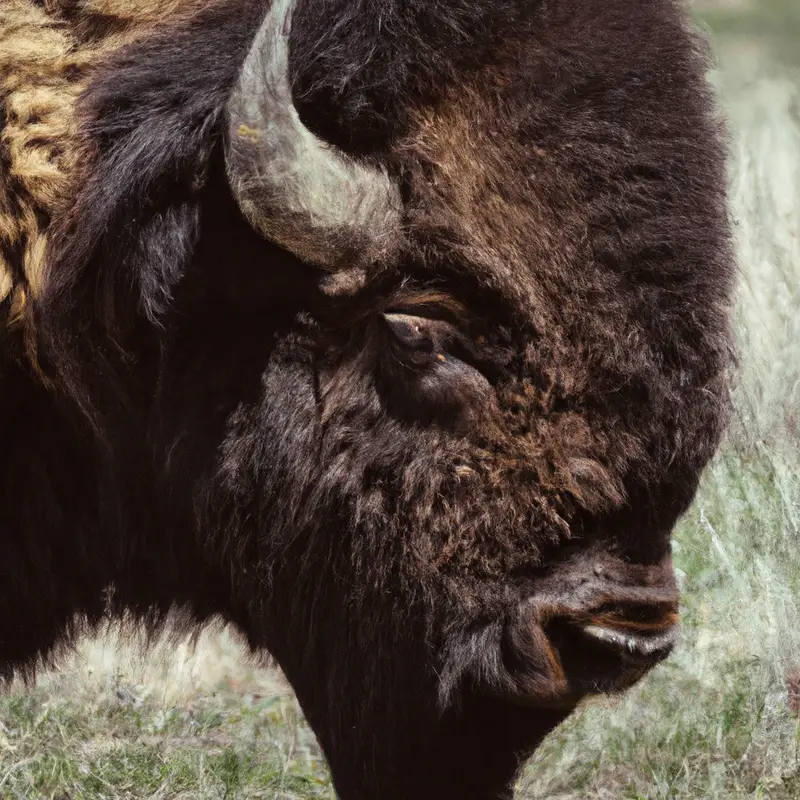
Hunting Regulations and Permits
Overview of hunting regulations in Alaska
Hunting regulations in Alaska are designed to ensure the sustainability of wildlife populations and maintain a balanced ecosystem.
The state manages hunting seasons, bag limits, and licensing requirements to protect species and promote ethical hunting practices.
Hunters must obtain the appropriate permits and licenses, which vary depending on the species they wish to hunt.
It is important to familiarize yourself with the specific regulations for each game species, as they vary and may have specific restrictions.
Additionally, it is essential to follow the principles of fair chase and practice ethical hunting to respect the environment and the animals.
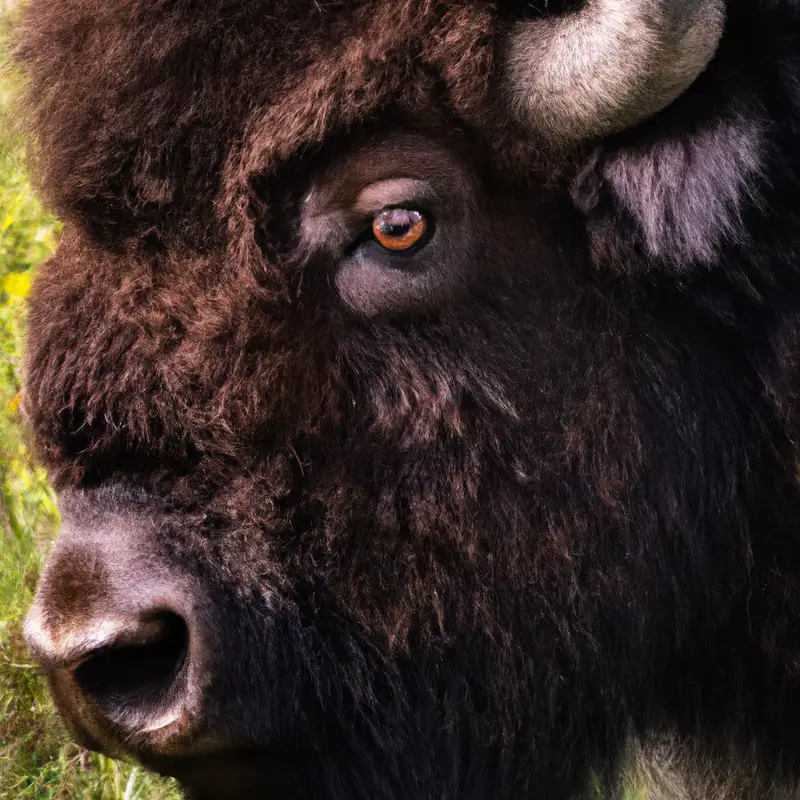
Specific regulations and requirements for hunting Bison
When hunting bison in Alaska, there are important regulations and requirements that you need to be aware of.
First, you must have a valid Alaska hunting license.
Additionally, a bison drawing permit is necessary, which can be obtained through a lottery system.
It is crucial to familiarize yourself with the specific hunting season dates and bag limits set by the Alaska Department of Fish and Game.
Finally, you must follow all safety guidelines and hunting ethics while pursuing bison.
Obtaining the necessary permits and licenses
To obtain the necessary permits and licenses for hunting bison in Alaska, there are a few steps you need to follow.
Firstly, you will need to complete a hunter education course to ensure you are aware of the hunting regulations.
After that, you can apply for the appropriate hunting license through the Alaska Department of Fish and Game website.
Additionally, if you plan to hunt on federal lands, you may need to acquire additional permits from the respective agencies.
Make sure to carefully review the requirements and deadlines to ensure a smooth hunt.
Preparation for Bison Hunting
Choosing the right hunting equipment and gear
Choosing the right hunting equipment and gear is essential for a successful and safe hunting trip. Here are some important factors to consider:
- Research: Before purchasing any equipment, research the specific requirements for bison hunting in Alaska. This will help you understand what gear is suitable for the terrain and weather conditions.
- Firearms: A powerful rifle chambered in a caliber suitable for big game, such as .300 Winchester Magnum, is recommended. Opt for a reliable and accurate firearm that you are comfortable with.
- Optics: High-quality binoculars are crucial for spotting bison from a distance. Look for a pair with adequate magnification and excellent low-light performance.
- Clothing: Invest in high-quality and durable camouflage clothing that provides warmth and protection. Layering is key, as temperatures can change rapidly in Alaska.
- Footwear: Sturdy and waterproof hunting boots are a must. Choose boots that provide ankle support and insulation to keep your feet comfortable in harsh conditions.
- Tracking and Field Gear: Pack essentials like a compass or GPS device, a field dressing kit, a game cart or pack frame for transporting the meat, and a quality backpack to carry your gear.
- Safety Equipment: Don’t forget about safety. Carry a reliable and properly fitted hunting knife, a first aid kit, bear spray, and any other necessary safety equipment.
By considering these factors and ensuring that you have the right hunting equipment and gear, you’ll be well-prepared for a successful and enjoyable bison hunt in Alaska.

Physical fitness and conditioning for the hunt
Physical fitness plays a vital role in preparing for a bison hunt. Being physically fit and well-conditioned will help you endure the challenging terrain and demanding hunting conditions.
It is important to focus on overall cardiovascular endurance, strength, and flexibility.
Activities such as running, hiking, and weight training can help improve your endurance and strength. Additionally, incorporating exercises that target your core and lower body muscles will enhance your stability and endurance during the hunt.
Remember to consult with a professional trainer to develop a personalized fitness plan that suits your needs.
Understanding the hunting area and scouting for Bison
Understanding the hunting area and scouting for Bison is key to a successful hunt.
First, gather information about the land, including terrain, vegetation, and weather conditions.
Look for signs of bison activity such as tracks, droppings, and grazing areas.
Second, use tools like binoculars and spotting scopes to scan the area for bison.
Look for herds or individual animals.
Lastly, plan your approach carefully, taking into account wind direction and cover.
Being patient, observant, and knowledgeable will greatly increase your chances of a successful bison hunt.
Techniques and Strategies for Bison Hunting
Spot-and-stalk method for locating Bison
Spot-and-stalk is a popular and effective method for locating bison during a hunt.
Here’s how it works:
- Use binoculars or a spotting scope to scan the terrain for bison. Look for movement or dark shapes against the landscape.
- Once you spot a group of bison, plan your approach carefully. Consider wind direction, terrain features, and available cover.
- Move slowly and quietly, keeping a low profile. Stay hidden behind rocks, trees, or bushes when possible.
- Use the landscape to your advantage, using natural features to mask your approach.
- Keep an eye on the bison’s behavior. If they become alert or start moving away, freeze in place and wait for them to settle before continuing your stalk.
- Maintain patience and persistence. Stalking bison can be challenging, requiring you to navigate difficult terrain and adapt to changing conditions.
- When you’re within range, carefully select your shot and take your time to ensure an ethical kill.
By employing the spot-and-stalk method, you increase your chances of locating bison and executing a successful hunt.
Remember to always prioritize safety and respect for the animal.
Calling and attracting Bison during the hunt
During a bison hunt, calling and attracting these massive creatures can greatly increase your chances of success.
One effective way to attract bison is to use a bison cow call, which mimics the sounds of a female bison in distress or in heat.
This can trigger a response from dominant males in the area.
Another technique is to use visual cues such as decoys or flagging, which simulate movement and can grab the attention of nearby bison.
Additionally, using scent attractants like bison urine or gland secretions can help lure bison closer to your hunting area.
Concealment and scent control for hunting success
When hunting for bison in Alaska, concealment and scent control are essential for success.
By minimizing your scent, you can prevent bison from detecting your presence and becoming wary.
To achieve this, try using scent-reducing sprays or soaps and wash your hunting gear in odor-neutralizing detergent.
Additionally, choose camouflage clothing that blends well with the surroundings and use natural cover to hide your movements.
Remember, paying attention to concealment and scent control can greatly increase your chances of a successful hunt.
Ethical Considerations and Conservation
Ethical hunting practices and respecting the animal
When it comes to hunting, practicing ethics and respecting the animal are crucial aspects.
Here are a few guidelines to follow:
- Quick and clean kill: Use ethical hunting techniques and equipment to ensure a swift and humane kill.
- Respect for the animal: Treat the animal with dignity and respect throughout the entire hunting process. Handle the carcass carefully and utilize as much of the animal as possible.
- Sustainable practices: Follow local hunting regulations and guidelines to ensure the long-term conservation of the species. Only hunt in designated areas and respect bag limits.
- Honoring the animal: Take the time to properly field dress and process the animal. Don’t waste any part of it; use as much as possible.
- Responsible hunting behavior: Be considerate of other hunters and respect their space. Practice firearm safety, and minimize any unnecessary harm to the environment.
By incorporating these ethical hunting practices and showing respect for the animal, we can ensure a responsible and sustainable approach to hunting.
The importance of sustainable hunting for Bison population
Sustainable hunting is crucial for the Bison population. It helps control their numbers and prevent overpopulation, which can lead to competition for resources and disease spread.
Controlled hunting also ensures that the Bison population remains genetically diverse and healthy.
Additionally, hunting can provide economic benefits for local communities and promote conservation efforts. When hunting is done sustainably, it becomes a tool for managing wildlife populations and maintaining ecological balance.
Contributing to Bison conservation efforts
If you want to contribute to bison conservation efforts, there are several ways you can help.
One of the most significant ways is to support organizations that work towards conserving bison populations and their habitats.
You can do this by making donations, volunteering your time, or participating in awareness campaigns.
Another way to contribute is by promoting sustainable practices, such as responsible grazing management and habitat restoration.
Additionally, educating yourself and others about the importance of bison conservation can make a difference.
Remember, every small effort counts towards the larger goal of protecting these iconic animals for future generations.
After the Hunt: Field Dressing and Processing
Field dressing the Bison properly
Field dressing a bison properly is essential to ensure the meat stays fresh and free from contamination.
Here’s what you need to remember:
- Start by field dressing the bison as soon as possible after the hunt.
- Use a sharp knife to make a clean cut across the belly, from the sternum to the anus.
- Carefully remove the internal organs, being cautious not to puncture or damage them.
- Make sure to remove the bladder, intestines, and all other organs.
- Check for any signs of disease or infection and discard any meat that appears spoiled.
- Allow the carcass to cool down and dry before further processing or transporting.
- Remember to properly dispose of the entrails, ensuring no traces are left behind.
Transportation and storage of Bison meat
Transporting and storing bison meat is important to ensure its freshness and safety. Here are some tips:
- After field dressing, cool the meat as quickly as possible to prevent spoilage.
- Transport the meat in a clean and insulated cooler with ice or ice packs to maintain a proper temperature.
- Once home, store the meat in a refrigerator or freezer.
- If freezing, package the meat in airtight containers or vacuum-sealed bags to prevent freezer burn.
- Label and date the packages for easy identification.
Remember, proper transportation and storage practices are essential for maintaining the quality of your bison meat.
Tips for processing Bison meat at home
When processing bison meat at home, there are a few important tips to keep in mind. First, make sure to have a clean and organized workspace, as proper hygiene is crucial to prevent foodborne illnesses.
Secondly, use sharp knives and cutting boards to ensure clean and precise cuts.
Additionally, it’s essential to properly label and store the meat to maintain its freshness. Lastly, consider using a meat grinder for ground bison meat, as it allows for greater control over the texture.
Happy processing!
Traditional Uses and Modern Culinary Delights
Traditional uses of Bison in Alaska Native culture
Bison holds significant importance in the traditional culture of Alaska Natives.
They have been relied upon for food, clothing, shelter, and tools for centuries.
The meat provided sustenance, while the hide was used for clothing and shelter.
Bones were crafted into tools, and sinew became thread for sewing.
Every part of the bison was utilized, ensuring efficient and sustainable use.
Today, Alaska Native communities continue to honor their ancestors by preserving and practicing these traditional uses, keeping their cultural heritage alive.
Exploring modern Bison recipes and cooking techniques
When it comes to exploring modern Bison recipes and cooking techniques, there are several delicious options to try. One popular method is to grill Bison steaks, which can be seasoned with a variety of herbs and spices to enhance the flavor.
Additionally, Bison burgers are a tasty alternative to beef burgers.
They can be topped with traditional ingredients like cheese and pickles, or you can get creative with unique toppings such as caramelized onions or avocado. Another option is to slow-cook Bison in a stew or chili for a hearty and flavorful meal.
Overall, Bison meat offers a range of possibilities for creating delicious and healthy dishes.
Popular Bison dishes and their nutritional benefits
Popular Bison dishes not only offer delicious flavors but also come with numerous nutritional benefits. Bison meat is leaner than beef, making it a healthier choice.
It is high in protein, essential amino acids, and minerals like iron and zinc.
Some popular bison dishes include bison burgers, bison steak, and bison chili. These dishes not only satisfy your taste buds but also provide important nutrients for your body.
Incorporating bison into your diet can be a tasty and nutritious way to enjoy a meal.
Final Verdict
Hunting Bison in Alaska is a thrilling and rewarding experience for those seeking adventure and a connection with nature.
Understanding the physical characteristics and behavior of Bison, as well as their importance to the ecosystem, is crucial for responsible hunting.
Obtaining the necessary permits and licenses, preparing with the right equipment and physical fitness, and utilizing effective hunting techniques and strategies are essential for a successful hunt.
It is also important to practice ethical hunting and contribute to Bison conservation efforts.
Finally, after the hunt, proper field dressing and processing techniques ensure the preservation and enjoyment of the Bison meat.
With its rich cultural heritage and nutritional benefits, Bison hunting in Alaska truly offers a unique and fulfilling experience.
